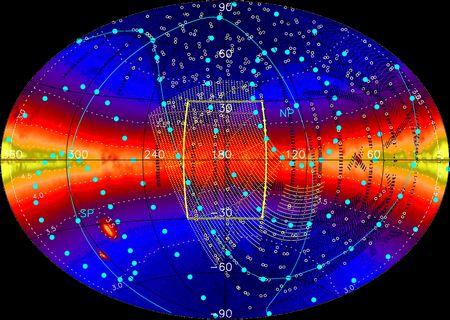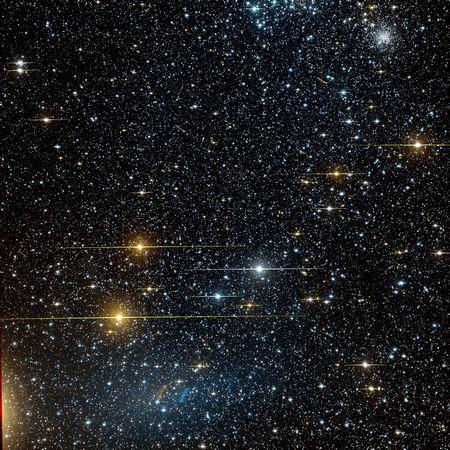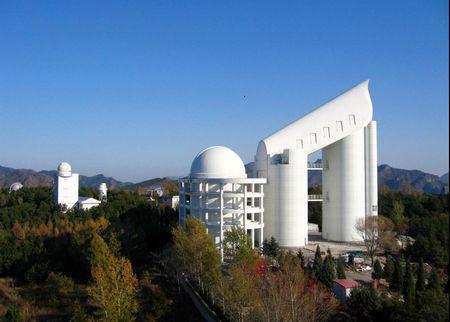Peking University, Mar. 10, 2011: A team led by Professor Liu Xiaowei from the Department of Astronomy and the Kavli Institute for Astronomy and Astrophysics of Peking University has completed the data collection of a large CCD Photometric Survey of the galactic anti-center on March 8 after two years' observation.
The survey was carried out in collaboration with Professors Zhao Haibin and Yao Jinsheng of the Xuyi Astronomical Observatory in east China s Jiangsu province. The observatory owns and operates the Near Earth Object Survey Telescope.

Sky coverage of the Xuyi Schmidt Photometric Survey (the central yellow dotted area) and the follow-up Guoshoujing Telescope Spectroscopic Survey (yellow box at the center) areas

A g, r, i three band synthesized true color image obtained with the Xuyi Schmidt Telescope

The Near Earth Object Survey Telescope in Xuyi

The Guoshoujing Telescope
The Xuyi Schmidt Photometric Survey will provide positions, photometric data, and an input catalog for the forthcoming digital sky survey of the galactic anti-center, which is to be carried out with the newly built national key astronomical observation facility, the Guoshoujing Telescope. Utilizing the 4,000 fibers afforded by the Guoshoujing Telescope, the survey will eventually obtain intermediate resolution optical spectra for a statistically complete sample of about four million stars distributed in a contiguous sky area of over three thousand square degrees in the direction of the Galactic anti-center. In the three colors (g-, r-, and i-band) used by the Sloan Digital Sky Survey, images from the Xuyi Schmidt photometric survey make up a sky area of over 5,000 square degrees centered on the Galactic anti-center, plus an extension of over 600 square degrees to the area of the Andromeda Galaxy (M 31) and the Triangulum Pinwheel Galaxy of the Local Group. Preliminary data analyses show that the survey yields an astrometric accuracy of 0.1 seconds of arc and a photometric accuracy of 1-2%, numbers comparable to the Sloan Digital Sky Survey. The survey reaches a limiting magnitude of 20 and is expected to yield a catalog of over 100 million Galactic stars.
The Milky Way is an archetypical giant spiral galaxy or disk galaxy. The disk, the defining component of the Milky Way, contains most of the baryonic matter and essentially all the angular momentum of the galaxy. Revealing the formation and evolution history of disk galaxies in the bottom-up galaxy formation paradigm of the Lambda-CDM dominated cosmological framework, i.e. discovering how a disk galaxy like our own assembled from pieces of pre-galactic substructures and acquired its characteristic morphology, structure and chemical and kinematic properties (known as the "grand design") is one of the most intriguing astrophysical problems of the 21st century. The Xuyi Schmidt Photometric Survey and the follow-up spectroscopic survey with the Guoshoujing Telescope will provide a huge data set with which to tackle this forefront problem. Successful completion of the survey will signify the arrival of Chinese astronomers at the global stage and a transitional shift in the world's center of gravity in observational astronomy.
The Purple Mountain Astronomical Observatory of the Chinese Academy of Sciences, the National Astronomical Observatories, and the National Natural Science Foundation supported the survey and associated research.
Extended Reading:
A Big Step Forward to the Digital Sky Survey of the Galactic Anti-center
DSS-GAC: A Digital Sky Survey of the Galactic Anti-center
The Guoshoujing TelescopeThe Xuyi Near Earth Object ObservatoryThe Sloan Digital Sky Survey
Translated by: Chen Meng
Edited by: Jacques
Source: PKU News (Chinese)
Related News
Photos
More>>history
Traditions
- Unveiling Ceremony of Confucius Institute of Moscow State University Held
- Chomsky Receives PKU Honorary Doctorate, His Lecture Depicts World Order
- Strategy for Global Partnerships
- PKU President Zhou Qifeng Attends New York Alumni Association Annual Meeting
- U.S. Council of Foreign Relations President Richard Haass Speaks at PKU





